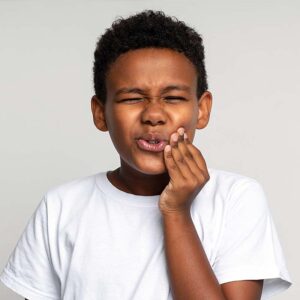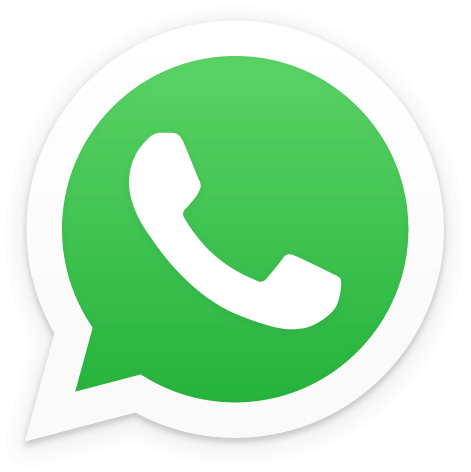Emergency Dental Treatment for Kids
Fast, reliable emergency dental care near you. Experienced pediatric dentist is available for immediate treatment.

Approximately one third of children have experienced some type of dental trauma, and more have experienced a dental emergency.
There are two peak risk periods for dental trauma – the first being toddlerhood (18-40 months) when environmental exploration begins, and the second being the preadolescent/adolescent period, when sporting injuries become commonplace.
Detailed below are some of the most common childhood dental emergencies, in addition to helpful advice on how to deal with them.
Toothache is common in children of all ages and rarely occurs without cause.
Impacted food can cause discomfort in young children, and can be dislodged using a toothbrush, a clean finger, or dental floss.
If pain persists, contact the pediatric dentist. Some common causes of toothache include: Impacted food particles, tooth fractures, tooth decay, tooth trauma, dental infection in root canal treated tooth, tooth about to exfoliate and wisdom teeth eruption (adolescence).
How you can help:
- Rinse your child’s mouth with warm water and make sure your child’s mouth is clean and there is no food particle by brushing or flossing slowly. Check for impacted food and remove it as necessary.
- Give your child Over counter Brufen or Panadol syrup
- Apply a cold compress to the affected area to reduce swelling.
- Contact the pediatric dentist to seek advice.
- Food particle or object may be caught in child’s mouth is common dental emergency accompanied by pain
- It is important to notice the object and remove with tooth brush or dental floss or tooth pick if object is stuck between the tooth
- If child has cavities on top surface of teeth than food particle or object may have lodged and can be removed easily by tooth pick or tooth brush
- Keep in mind that you should never use sharp tools to remove the stock object as it will result in more damages to the teeth and possibly the gum.
- If you succeed – perfect, if not – please give us a call and come for a visit.
Dental abscess is an infection that appears at the roots of the teeth and its symptoms are sudden fever, swollen gums or sudden bad taste in the mouth.
Most common cause of dental abscess is due to untreated dental decay which starts at crown portion of tooth and spreads at root portion of tooth accompanied by ‘gum boil’ near crown and root junction portion of tooth in children. In medical terminology it’s called ‘Dentoalveolar abscess’. It is accompanied by intra oral abscess alone with sinus opening or Intraoral abscess accompanied by extra oral swelling in jaw area
Other reason may be food lodged between tooth or at the end of last tooth inside the gum portion of tooth may irritate the gum and cause infection called ‘Space infection’ in children.
If your child is experiencing dental abscess, you should bring your child to us immediately to find out the cause and take the necessary measures. Untreated infection in the mouth can easily spread to other parts of the body and lead to more serious medical conditions.
Pericoronitis is a condition found in children whose molars are in the process of erupting through the gum. As the molar emerges, a flap of gum still covers the tooth. The flap of gum traps bacteria and food. Leading to mild pain to severe pain, difficulty in mouth opening and extraoral swelling.
If your child experience any of these symptoms. It is recommended to call us immediately and fix emergency appointment
- Use a folded piece of gauze, place it on bleeding area and bite firmly.
- Ask child to bite the gauze for 30 minutes till bleeding stops.
- Repeat the process if needed and if bleeding doesn’t stop call us
- Apply ice or cold compress or have plain ice cream. Consumption of cold food stuff will have soothing effect and relieve pain.
If your child has a baby tooth that is severly loose, it must be removed to avoid being swallowed or inhaled. If you need help with removing tooth, please give us a call.
Cause of loose baby tooth
- Permanent tooth is erupting pushing baby tooth making it loose
- Baby tooth hit by object or fall
In case it’s a permanent tooth, this is considered as emergency and you should bring your child immediately for emergency appointment
Cause of permanent tooth looseness
- Dental trauma is most common cause of permanent tooth looseness
- Bone loss secondary to gum disease
Avulsion injury (Knocked-out permanent adult tooth/ Baby tooth)
If a tooth has been knocked-out of the child’s mouth completely, it is important to contact the pediatric dentist immediately.
Knocked out baby tooth
In general, pediatric dentists do not attempt to reimplant avulsed primary (baby) teeth, because the reimplantation procedure itself can cause damage to the tooth bud, and thereby damage the emerging permanent tooth.
Knocked out permanent adult tooth
Pediatric dentists always attempt to reimplant avulsed permanent teeth, unless the trauma has caused irreparable damage. The reimplantation procedure is almost always more successful if it is performed within one hour of the avulsion, so time is of the essence!
How you can help:
- Recover the tooth. Do not touch the tooth roots! Handle the crown only.
- Rinse off dirt and debris with water without scrubbing or scraping the tooth.
- For older children, insert the tooth into its original socket using gentle pressure, or encourage the child to place the tooth in the cheek pouch. For younger children, submerge the tooth in a glass of milk or saliva (do not attempt to reinsert the tooth in case the child swallows it).
- Do not allow the tooth to dry during transportation. Moisture is critically important for reimplantation success.
- Visit the pediatric dentist (where possible) or take the child to the Emergency Room immediately –time is critical in saving the tooth.
Sometimes, dental trauma forces a tooth (or several teeth) upwards into the jawbone. The prognosis is better for teeth that have been pushed up to a lesser extent (less than 3mm), but every situation is unique. Oftentimes, the force of the trauma is great enough to injure the tooth’s ligament and fracture its socket.
If dental intrusion of either the primary or permanent teeth is suspected, it is important to contact the pediatric dentist immediately. Depending on the nature and depth of the intrusion, the pediatric dentist will either wait for the tooth to descend naturally, or perform root canal therapy to preserve the structure of the tooth.
How you can help:
- Rinse the child’s mouth with cold water.
- Place ice packs around affected areas to reduce swelling.
- Offer Tylenol for pain relief.
- Contact the pediatric dentist where possible, or proceed to the Emergency Room.
Tooth displacement is generally classified as “luxation,” “extrusion,” or “lateral displacement,” depending on the orientation of the tooth following trauma. A luxated tooth remains in the socket – with the pulp intact about half of the time. However, the tooth protrudes at an unnatural angle and the underlying jawbone is oftentimes fractured.
The term “extrusion” refers to a tooth that has become partly removed from its socket. In young children, primary tooth extrusions tend to heal themselves without medical treatment. However, dental treatment should be sought for permanent teeth that have been displaced in any manner in order to save the tooth and prevent infection. It is important to contact the pediatric dentist if displacement is suspected.
How you can help:
- Place a cold, moist compress on the affected area.
- Offer pain relief (for example, Children’s Panadol).
- Contact the pediatric dentist immediately.
The crown is the largest, most visible part of the tooth. In most cases, the crown is the part of the tooth that sustains trauma. There are several classifications of crown fracture, ranging from minor enamel cracks (not an emergency) to pulp exposure (requiring immediate treatment).
The pediatric dentist can readily assess the severity of the fracture using dental X-rays, but any change in tooth color (for example, pinkish or yellowish tinges inside the tooth) is an emergency warning sign. Minor crown fractures often warrant the application of dental sealant, whereas more severe crown fractures sometimes require pulp treatments. In the case of crown fracture, the pediatric dentist should be contacted. Jagged enamel can irritate and inflame soft oral tissues, causing infection.
How you can help:
- Rinse the child’s mouth with warm water.
- Place a cold, moist compress on the affected area.
- Offer strong pain relief (for example, Children’s panadol).
- Pack the tooth with a biocompatible material.
- Visit the pediatric dentist or Emergency Room depending on availability and the severity of the injury.
A root fracture is caused by direct trauma and isn’t noticeable to the naked eye.
If a root fracture is suspected, dental x-rays need to be taken. Depending on the exact positioning of the fracture and the child’s level of discomfort, the tooth can be monitored, treated, or extracted as a worst-case scenario.
How you can help:
- Place a cold, moist compress on the affected area.
- Offer pain relief (for example, Children’s panadol).
- Contact the pediatric dentist.
A tooth that has not been dislodged from its socket or fractured, but has received a bang or knock, can be described as “concussed.” Typically occurring in toddlers, concussion injury can cause the tooth to discolor permanently or temporarily. Unless the tooth turns black or dark (indicating that the tooth is dying and may require root canal therapy), concussion injury does not require emergency treatment.
If the child’s cheek, lip or tongue is bleeding due to an accidental cut or bite, apply firm direct pressure to the area using a clean cloth or gauze.
To reduce swelling, apply ice to the affected areas.
If bleeding doesn’t stop call The Kids Dentist 0545567296
If a broken or fractured jaw is suspected, proceed immediately to the Emergency Room. In the meantime, encourage the child not to move the jaw.
If your child had a bad fall or sports accident and has any of these complaints he or she might have fractured or broken jaw:
- Your child is unable to open mouth
- Malalignment of jaw upon opening
- Child has uneven bite and teeth positioning looks different from before incident
- Your child can’t close their teeth properly
How can you help?
- Gently tie a scarf lengthways around the head and jaw to prevent movement.
- Apply cold compress to ease pain and reduce swelling
- Bring the child to our clinic to get the help required
If the child has received trauma to the head, proceed immediately to the Emergency Room. Even if consciousness has not been lost, it is important for pediatric doctors to rule out delayed concussion and internal bleeding.

More questions?
If you have questions or concerns, please call The Kids Dentist on 0545567296 or fill in our Online Booking Form and we’ll be in touch.


